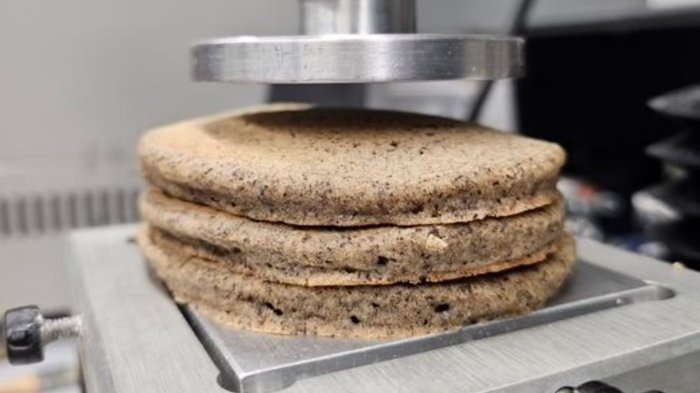Eddie Gonzales Jr. – MessageToEagle.com – Typical breakfast pancakes are soft, fluffy and delicious but, sadly, not terribly healthy.
Food scientists at Washington State University are working to change that by boosting the popular morning favorite’s nutritional value while enhancing its taste and texture.
WSU scientists used different lab equipment, like this one that evaluates texture, to measure the impact of using different ratios of whole wheat flours in pancakes.
Image credit: Girish Ganjyal/WSU
“Generally, pancakes are made with refined flours, contributing to empty calories,” said Girish Ganjyal, a professor and food processing specialist in WSU’s School of Food Science. “We wanted to see if it’s possible to make tasty pancakes with whole grains that add some fiber and protein.”
Ganjyal and his study co-authors replaced refined flour with whole-grain buckwheat, quinoa, millet, and whole-wheat flours in a variety of percentages ranging from 25% up to 100% apiece. The encouraging results were published in the journal Cereal Chemistry.
The team found that buckwheat, quinoa, and whole-wheat flours can be mixed into pancake recipes without significant changes to the taste or texture. The millet flour had to be slightly pre-cooked before it could be added seamlessly.
“We started with a small level of replacement flours, then kept increasing them until it wasn’t practical,” Ganjyal said. “With millet flour, for example, we found that it basically just crumbles; there was no binding.”
The scientists used the same recipe for all the pancakes. The different flours were the only variable, and the recipe’s leavening system and other ingredients like sugar, oil, flour, and salt remained constant. The recipes with the different flours and percentages were compared with the control pancakes, which were made with refined flour and all of the same other ingredients.
The study was part of WSU’s Soil to Society project, which launched in 2021 with a grant from the USDA’s National Institute of Food and Agriculture. The project takes a comprehensive approach to increasing foods’ nutrient values and involves a multi-disciplinary team of plant breeders, nutrition experts, and food scientists. Ganjyal hopes flour manufacturers will use the research to produce healthier products for restaurants and consumers.
He is already continuing the research by trying to understand why various flours behave differently under cooking conditions. He and his team hope to modify the flours so their textures become indistinguishable from the refined version.
The original project required cooking many pancakes and then measuring them at various points throughout the process for different traits like viscosity, cook time, size, and texture. The paper’s co-authors included a WSU graduate student, an undergraduate, and a high school intern with the Soil to Society project.
“She spent a lot of time over a griddle,” Ganjyal said. “She also learned the fundamentals of how we do our work. One of the best parts of my job is training the next generation, and hands-on experience like this lets students see how we can help improve the food system for everyone. I have been lucky to have brilliant students in my research and Extension program.”
Written by Eddie Gonzales Jr. – MessageToEagle.com Staff Writer







